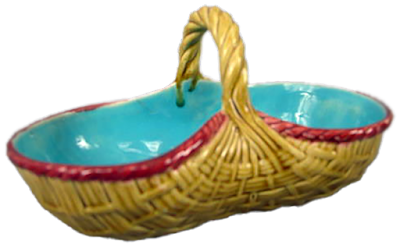Majolica baskets are such a large topic that I don't know where to start!
I've already tackled this subject twice before, one in my discussion of
egg baskets and once while showing
strawberry servers. Both forms include a number of baskets.
The inclusion of wicker as a majolica subject goes back to some of the earliest majolica pieces created by Minton. It seems only natural that handled baskets would ultimately appear in majolica as well. From the stately workrooms of Minton to the homespun Etruscan Works in Phoenixville, there are baskets of all shapes and sizes, though not all are an imitation of wicker. Take, for example the fanciful Continental Art Nouveau basket below.
Eichwald majolica basket
Most baskets, however, are indeed imitations of wicker or leaves...
Fielding majolica floral basket
Wardle majolica basket
Holdccroft majolica basket
Fielding Argenta majolica basket
or bird's nests...
Royal Worcester majolica bird's nest basket
or fish!
Bevington majolica fish basket
But most are just fanciful baskets made from wicker or wood.
Banks & Thorley majolica basket
Copeland majolica basket
Brownfield majolica basket
Continental majolica asparagus basket
Unattributed majolica rustic basket
Same basket as above but with a nest
One thing that all of these baskets share in common is their delicacy. Unlike real baskets, ceramic baskets are easily damaged. When buying baskets always examine the area where the handle joins the body. This is the area most likely to break and the area most likely to have a repair.
Regardless of whether a basket has a repair or not NEVER hold the piece by the handle. Doing so is just asking for trouble.
Forester majolica barbotine basket
Forester majolica basket
Forester majolica cockatoo basket
Forester majolica holly basket
Forester majolica basket
Fielding majolica Fan basket
Some baskets are marked, like these Holdcroft baskets...
Holdcroft majolica morning glory basket
Holdcroft majolica strawberry server
...or these Wedgwood baskets...
Wedgwood majolica bamboo basket
Wedgwood majolica wicker basket
Wedgwood majolica strawberry server
Wedgwood majolica grape and strawberry basket
Wedgwood majolica strawberry server
...or these George Jones baskets...
George Jones majolica strawberry server basket
George Jones majolica basket
George Jones majolica strawberry server basket
George Jones majolica strawberry server basket
George Jones majolica strawberry basket
George Jones majolica basket
...or these Minton baskets...
Minton majolica basket with robins
Minton majolica lily basket
Minton majolica double basket
Minton majolica wicker basket
...or these Etruscan baskets...
Etruscan Majolica begonia leaf on wicker basket
Etruscan Majolica wicker basket
...but most are not. Still the basket form was very popular among many majolica potteries and often used as egg servers or strawberry servers or whatever!
Fielding majolica egg basket
Skey Wilncoate Ware majolica egg basket
Massier majolica floral basket
Massier majolica floral basket
Massier majolica daisy basket
Massier majolica bird basket
Schiller & Son majolica basket Onnaing majolica basket
Victoria Pottery Company majolica basket
Adams & Bromley waterlily basket
Wardle majolica basket
It really is quite remarkable that so many of these delicate baskets still exist, more than a hundred years after they were created. I think this speaks of how much these were loved and cared for since they were new.
How could anyone resist filling them with candy or flowers!

Salopian Pottery majolica rose basket
















































































